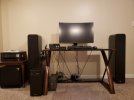Cars-N-Cans
Addicted to Fun and Learning
By using a suitably long room, of course. Basically its a "Live End Dead End" configuration. Keep in mind that the reflection has to travel out, bounce off of the rearmost wall, and come back, and with roughly 19' each way, it works out to about 30ms, which is right at the very end of the fusion window. That one is critical to getting the proper tonality since its a diffuse sound field from both speakers. This stops it from sounding anechoic. I'm sure with suitable EQ that could be eliminated and just the direct sound field used (we do this all the time with headphones as part of the Harman target), but doing it this way means that the radiation pattern of the speaker and acoustic measurements can be used to determine what the target response should be, which is not straightforward from how its configured below with large speakers close to the wall, not to mention the headaches associated (no pun intended) with sitting so close to a sub. Its hard to get it properly integrated without the bass ending up in just one channel. As far as the speakers, in this case the Polk S55's I have act more or less as a point source above about 1 kHz and have the tweeter at just the right height below ear level, but I have gotten it to work with other two-way speakers. Three-way not so much due to there not being enough distance for the sound to integrate properly. I have the speakers set up such that the desk reflections miss me as well as not being aligned with any axis, which is critical to getting the crosstalk down at the opposing ear. Even so, its probably close to the bare minimum for the effect to work as I'm only getting around 10 dB of reduction at each contralateral ear. Not shown in the picture is the rest of the room, and I still need to treat the wall behind the speakers as impulsive sounds can survive multiple trips back and forth which gives a distinct flutter echo, but overall its the only way I have found to easily get binaural audio out of conventional loudspeakers, but the caveat is that its tuned to the characteristics of my hearing. So far, other family members just say it sounds like "really good speakers" so I'm not sure what the limits are for the effect working in regards to psychoacoustics. Edit: I should probably state that the TL;DR of the sound quality is accurate azimuthal (from about my extreme left and right) and distance being reproduced with suitable miking, with each sound source being separate and distinct. This gives the same deep contrast as large headphones that comply with the Harman target, but with the placing of instruments being more realistic and accurate. With headphones for me the sound sources more or less end up in a line slightly behind my head along the axis of the ears.What do you mean the first 20ms? Sound travels 22.5’ in .02 seconds. You don’t sit 22.5’ away from the speakers right? You have absorption on the walls for 22.5’? How do you control the time of arrival of the first reflections? This is making no sense to me.
Attachments
Last edited:

